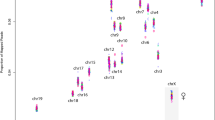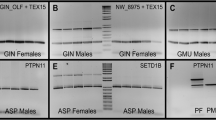Abstract
Molecular tests of sex based on the polymerase chain reaction (PCR) are now commonplace in conservation biology, routinely guiding management decisions. While molecular approaches to sexing can be highly reliable, current practices may leave an undesirable level of uncertainty in the sexes identified, because researchers focus on determining the sex-specific nature of a test, largely ignoring the accuracy of the test to correctly sex individuals. This latter step requires considerably more known-sex individuals. We argue that, due to the well-known technical problems associated with PCR amplification, the demonstrated potential for sexing errors and few known-sex individuals being available from threatened species, conservationists should place greater emphasis on verifying the sexes identified with PCR tests. We propose that all individuals of the sex indistinguishable from an amplification failure (e.g., females in mammals XX, males in birds ZZ) should be verified with a second independent sex test. Such a consensus approach to molecular sexing would reduce errors that could arise due to technical failure and PCR anomalies, but may also reduce field and laboratory bookkeeping errors.
Similar content being viewed by others
References
Arnold KE, Orr KJ, Griffiths R (2003) Primary sex ratios in birds: Problems with molecular sex identification of undeveloped eggs. Molec. Ecol., 12, 3451–3458
Blomqvist D, Andersson M, Küpper C, Cuthill IC, Kis J, Lanctot RB, Sandercock BK, Szekely T, Wallander J, Kempenaers B (2002) Genetic similarity between mates and extra-pair parentage in three species of waders. Nature, 419, 613–615
Bradley BJ, Chambers KE, Vigilant L (2001) Accurate DNA-based sex identification of apes using non-invasive samples. Conserv. Genet., 2, 179–181
Clout MN, Elliott GP, Robertson BC (2002) Effects of supplementary feeding on the offspring sex ratio of kakapo: A dilemma for the conservation of a polygynous parrot. Biol. Conserv., 107, 13–18
Coughlan T, Schartl M, Hornung U, Hope I, Stewart A (1999) PCR-based sex test for Xiphophorus maculates. J. Fish Biol., 54, 218–222
Dawson DA, Darby S, Hunter FM, Krupa AP, Jones IL, Burke T (2001) A critique of avian CHD-based molecular sexing protocols illustrated by a Z-chromosome polymorphism detected in auklets. Mol. Ecol. Notes, 1, 201–204
Deputy J, Ming R, Ma H, Liu Z, Fitch M, Wang M, Manshardt R, Stiles J (2002) Molecular markers for sex determination in papaya (Carica papaya L.). Theor. Appl. Genet., 106, 107–111
Devlin RH, Park L, Sakhrani DM, Baker JD, Marshall AR, LaHood E, Kolesar SE, Mayo MR, Biagi CA, Uh M (2005) Variation of Y-chromosome DNA markers in Chinook salmon (Oncorhynchus tshawytscha). Can. J. Fish Aquat. Sci., 62, 1386–1399
Ewen JG, Cassey P, Møller AP (2004) Facultative primary sex ratio variation: A lack of evidence in birds? Proc. R. Soc. Lond. B Biol. Sci., 271, 1277–1282
Fridolfsson AK, Ellegren H (1999) A simple and universal method for molecular sexing of non-ratite birds. J. Avian Biol., 30, 116–121
Gagneux P, Boesch C, Woodruff DS (1997) Microsatellite scoring errors associated with noninvasive genotyping based on nuclear DNA amplified from shed hair. Mol. Ecol., 6, 861–868
Gowans S, Dalebout ML, Hooker SK, Whitehead H (2000) Reliability of photographic and molecular techniques for sexing northern bottlenose whales (Hyperoodon ampullatus). Can. J. Zool., 78, 1224–1229
Grant A (2001) DNA sexing of brown kiwi (Apteryx mantelli) from feather samples. DOC Science Internal Series 13. Department of Conservation, Wellington. 16p
Griffiths R (2000) Sex identification using DNA markers. In: Molecular Methods in Ecology (ed. Baker AJ), pp. 295–321, Blackwell Science, Oxford
Griffiths R, Tiwari B (1995) Identification of the sex of the last wild Spix’s macaw. Nature, 375, 454
Griffiths R, Double MC, Orr K, Dawson RJB (1998) A DNA test to sex most birds. Mol. Ecol., 7, 1071–1075
Groombridge JJ, Massey JG, Bruch JC et al. (2004) An attempt to recover the po’ouli by translocation and an appraisal of recovery strategy for bird species extreme rarity. Biol. Conserv., 118, 365–375
Handyside AH, Delhanty JDA (1993) Cleavage stage biopsy of human embryos and diagnosis of X-linked recessive disease. In: Preimplantation Diagnosis of Human Genetic Disease (ed. Edwards RG), pp. 239–270. Cambridge University Press, Cambridge
Handyside AH, Kontogianni EH, Hardy K, Winston RML (1990) Pregnancies from biopsied human preimplantation embryos sexed by Y-specific DNA amplification. Nature 334: 768–770
Hoffman JI, Amos W (2005) Microsatellite genotyping errors: Detection approaches, common sources and consequences for paternal exclusion. Mol. Ecol., 14, 599–612
Kohn MH, Wayne RK (1997) Facts from feces revisited. Trends Ecol. Evol., 12, 223–227
Lessells C, Mateman A (1998) Sexing birds using random amplified polymorphic DNA (RAPD) markers. Mol. Ecol., 7, 187–195
Pemberton JM, Slate J, Bancroft DR, Barrett JA (1995) Non amplifying alleles at microsatellite loci: a cautionary tale for parentage and population studies. Mol. Ecol., 4, 249–252
Pompanon F, Bonin A., Bellemain E, Taberlet P (2005) Genotyping errors: causes, consequences and solutions. Nat. Rev. Genet., 6, 847–859
Reed JZ, Tollit DJ, Thompson PM, Amos W (1997) Molecular scatology: The use of molecular genetic analysis to assign species, sex and individual identity to seal faeces. Mol. Ecol., 6, 225–234
Robertson BC, Millar CD, Minot EO, Merton DV, Lambert DM (2000) Sexing the critically endangered kakapo Strigops habroptilus. Emu, 100, 336–339
Shea BF (1999) Determining the sex of bovine embryos using polymerase chain reaction results: a six-year retrospective study. Theriogenology, 51, 841–854
Sutherland WJ (2002) Science, sex and the kakapo. Nature, 419, 265–266
Taberlet P, Griffin S, Goossens B et al. (1996) Reliable genotyping of samples with very low DNA quantities using PCR. Nucleic Acids Res., 24, 3189–3194
Whittingham LA, Dunn PO (2000) Offspring sex ratios in tree swallows: Females in better condition produce more sons. Mol. Ecol., 9, 1123–1129
Zeleny R, Bernreuther A, Schimmel H, Pauwels J (2002) Evaluation of PCR-based beef sexing methods. J. Agric. Food Chem., 50, 4169–4175
Acknowledgements
We thank Fred Allendorf, Jim Briskie, Terry Burke, Louise Chilvers, Debs Dawson, Raphael Didham, John Ewen, Sharyn Goldstien, Tania King, Ed Minot, Tammy Steeves and two anonymous reviewers for discussions and comments that improved the manuscript.
Author information
Authors and Affiliations
Corresponding author
Rights and permissions
About this article
Cite this article
Robertson, B., Gemmell, N. PCR-based sexing in conservation biology: Wrong answers from an accurate methodology?. Conserv Genet 7, 267–271 (2006). https://doi.org/10.1007/s10592-005-9105-6
Received:
Accepted:
Published:
Issue Date:
DOI: https://doi.org/10.1007/s10592-005-9105-6




